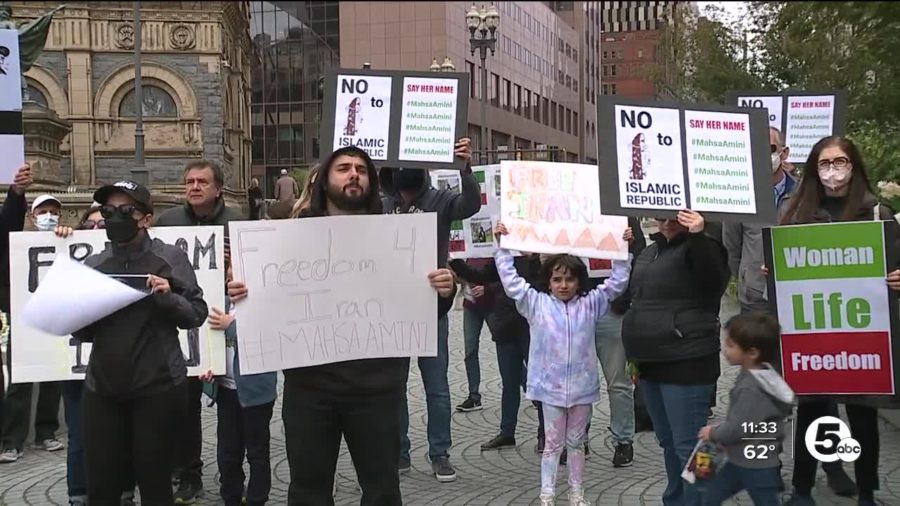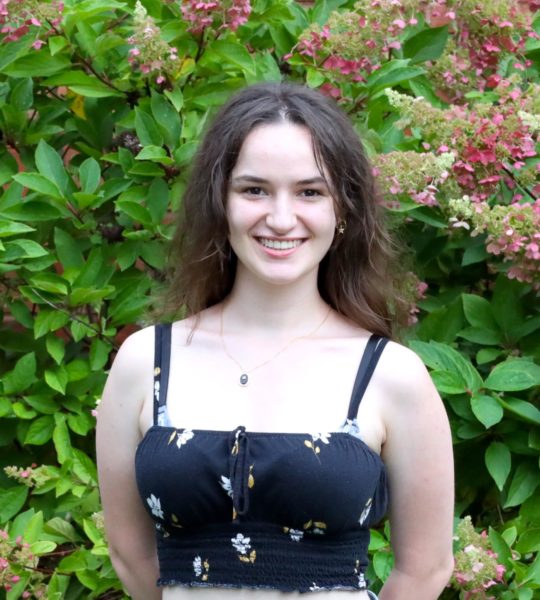Cleveland residents hold protests against the Iranian Government
CWRU administration condemns the Iranian Regime’s brutality following pressure from community
On Oct. 1, a large crowd holding signs with anti-regime slogans gathered in Public Square to protest the violence of the Iranian government.
October 7, 2022
On the afternoon of Saturday Oct. 1, residents of Cleveland joined those around the world protesting the Iranian Regime’s brutality towards women and their subsequent crackdown on those calling for reform. Over 200 people peacefully gathered in Public Square to show their support for the Iranian people, with many holding signs that said “Woman, Life, Freedom” and “No to Islamic Republic.” Protestors participated in shouting many anti-regime chants, and several women publicly cut their hair in demonstration of their solidarity.
Several individuals affiliated with Case Western Reserve University—who wished to be referred to as Alex, Ben and Cameron so as not to be targeted by the regime—were in attendance. “The main words [being chanted] were ‘death to the dictator,’” said Alex.
“We wanted to show that we are supporting the people in Iran, as opposed to what the supreme leader mentioned: that we [Iranians internationally] are betrayers to the country, and we are paid to do that,” Ben added. Iran’s supreme leader, Ayatollah Ali Khamenei, publicly addressed the protests for the first time at the beginning of the week, blaming the United States, Israel and other foreign powers for inciting the “rioting.”
On Sept. 13, a 22-year-old Kurdish-Iranian woman named Mahsa Amini was arrested and detained by Iran’s morality police for not wearing the compulsory hijab in accordance with government standards. Two hours after her arrest, her family was informed that she had suffered a heart attack and a seizure and was hospitalized in Tehran, where she later slipped into a coma. A picture of Amini in the hospital, unconscious and intubated, was posted, causing an uproar online. Amini succumbed to her injuries and died on Sept. 16.
According to the government, Amini’s cause of death was due to a sudden “heart problem” caused by a history of heart disease and a previous operation on her brain. However, the Amini family states that she had no such prior health conditions. In addition, the government was caught attempting to forge documents stating that Amini had heart problems prior to her arrest. On Sept. 21, the news outlet Iran International obtained CT scans of Amini’s brain, clearly depicting that she had endured a severe skull fracture, hemorrhages and edema prior to her death.
Just hours after she passed, crowds had already begun to form outside the hospital where she was held, and the slew of protests and demonstrations have only grown from there. At least 80 protests, spread throughout all 31 provinces of Iran, have erupted as a result of Amini’s death, along with many more worldwide. Many of these protests include anti-regime chants, women publicly cutting their hair, women burning their hijabs in the street and protestors attacking symbols and structures of the state. With a vast history of violence, the Iranian police have taken to shooting automatic rifles to break up protests. At least 130 protestors have been killed since the beginning of these demonstrations. Videos have been posted across social media depicting instances of human rights violations committed by the Iranian police, with many instances of brutality documented against protestors. Violent military blowback is especially strong in the Kordestan province and the northeast of Iraq—regions where Amini and many other Iranian Kurds originate—with reports of Iranian drones bombing these regions in the days following the start of these uprisings. Internet and telecommunications services have been severely disrupted all over the country, including a near-total internet blackout in Kordestan, all in an effort to prevent the spread of further protests.
This is far from the first large-scale protest to come out of Iran, but most of these protests do not have the universal appeal that this one does. This is a rare occasion in which the majority of Iranians are unanimous in their disdain for the regime.
“[Usually,] some people [think] that there shouldn’t be any change in regime, but a change in president, and some people…want to protest to change the regime,” said Alex. “This time…the majority of people are united…They want a change in regime—not change in the government, not changing the rules of hijab, not freedom in drinking alcohol, they don’t want that. They want a change in everything.”
“Unlike previous demonstrations in Iran, the latest protests are led by women, particularly young women. Women’s rights are at the forefront of these protests, as opposed to prior demonstrations that mostly focused on economic or political causes,” said Cameron. “Though women are leading the current protests in Iran, men have also joined them, denouncing the government’s intrusion into women’s private lives.”
The combination of these two events helped broaden this movement into a country-wide issue against the Islamic government.
“The people were waiting to show their anger, but several times, the government tried to oppress them. But this … was just a reason for the people to be united and try to change the regime. They [finally] concluded that there is no way for this regime to be corrected, and the basic rules in Iran are wrong,” said Alex. “It’s as if the people of Iran actually woke up from a sleep after 43 years.”
Along with the greater Iranian community around Cleveland, CWRU members have been advocating to bring this historic situation to light. Fourth-year psychology student Ghazal Adibi has been very involved in sharing information and helping with student protests.
“[I’m] mostly just posting on Instagram and other social media, trying to educate my non-Iranian friends about what’s going on,” said Adibi. “I organized a protest on campus and drove some students to protest downtown. We have been playing a lot of Persian songs, particularly “Baraye,” which is a song written specifically [for] these protests.”
Despite the gravity of this situation, CWRU president Eric Kaler and the CWRU administration have yet to release a statement condemning the human rights violations instilled by the morality police, despite several members of the community sending him emails requesting that he do so. For reference, Kaler and Executive Vice President and Provost Ben Vinson III released a statement condemning the Russian invasion of Ukraine less than 24 hours after it occurred.
Several Iranian members of the CWRU community have emailed the administration to bring this situation to their attention.
“I believe most Iranians at [CWRU] emailed [International Student Services] (ISS) and emailed the president himself,” Alex recalled. Kaler has yet to respond to these emails, and ISS has replied to the senders, reassuring them that they had heard about what’s happening and providing contact information if counseling is needed. However, that is not the response they wanted.
“Yes, we’re sad, we’re upset, but we’d at least expect the president to send an email and inform [everyone]. It’s the least they could do for us,” Alex continued. “This is something related to human rights. If they believe in human rights, and women’s rights, they have to show [who they support].”
“We don’t want the university to look at this from a political point of view,” Ben said. “If something like this happens in any country, we’d expect that they would put, at least, an announcement, and support the students from that region in what they’re going through, and inform other people about this.”
This is not the first instance where CWRU has given little to no attention to certain global crises, particularly to issues concerning the Middle East and Africa. In response, the Undergraduate Student Government (USG) drafted a resolution last semester that aims to establish “procedures for how CWRU’s administration can respond to global crises in a student-centric manner.” The resolution—which has yet to be voted on—asks the university to set up support groups to allow students a space to process their thoughts and feelings, establish a minimum level of funding for identity-based university offices, ensure that timely and clear communications on global crises are released and divest from companies that directly benefit from the military-industrial complex. Whether the university will take such action, even if USG passes the resolution, remains to be seen.
Addendum: The day after this article was edited and sent to print, President Kaler and Provost Vinson released a statement, stating that CWRU “stands together with our Iranian community and those impacted by these events, particularly Iranian women and students as well as those supporting them.” The statement also mentioned CWRU’s values of prioritizing gender equity, free speech, academic freedom and ethical behavior. This was released 20 days after the beginning of these protests, after at least 130 protestors lost their lives. The university did not explicitly condemn the Islamic Republic.



